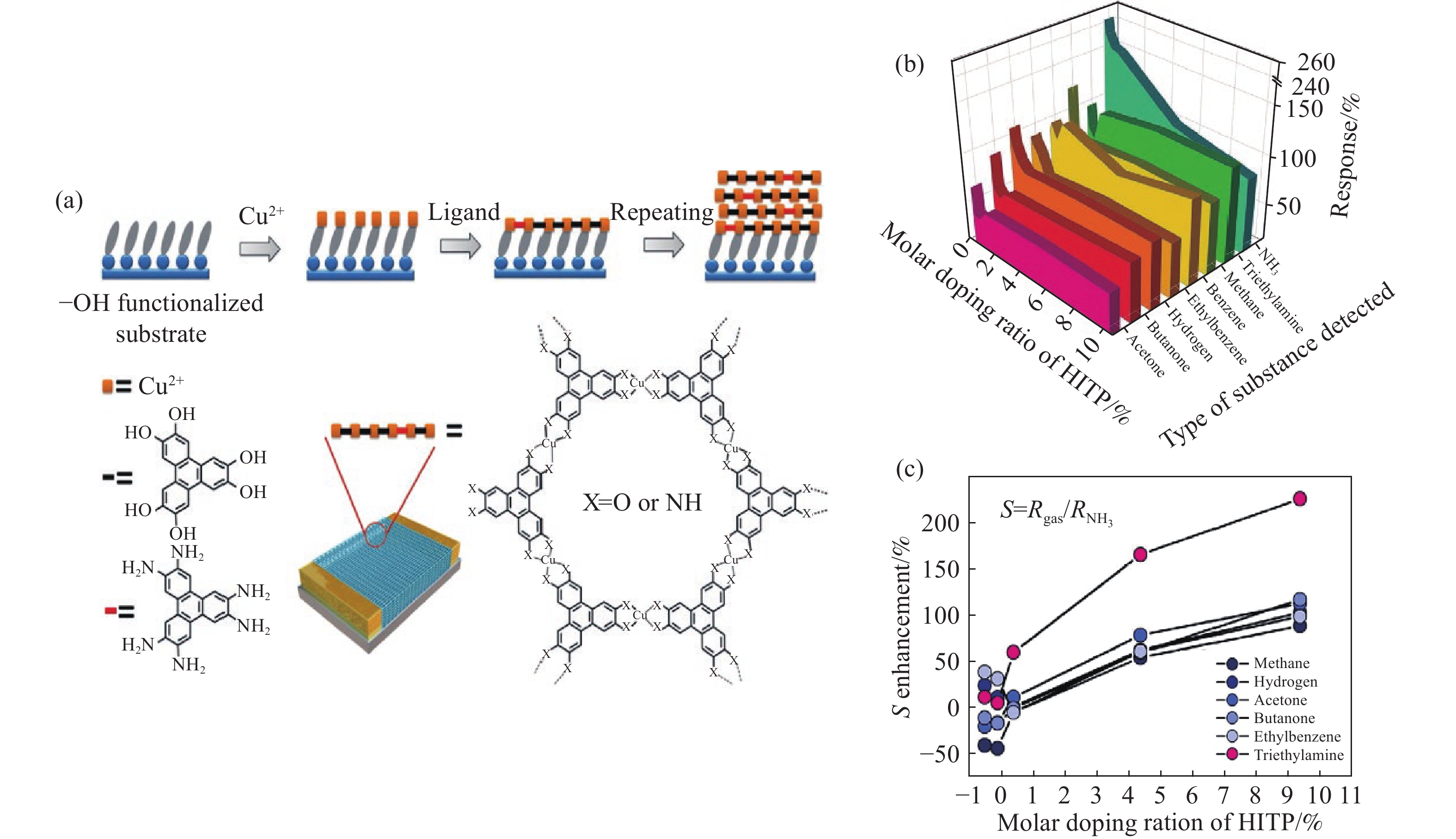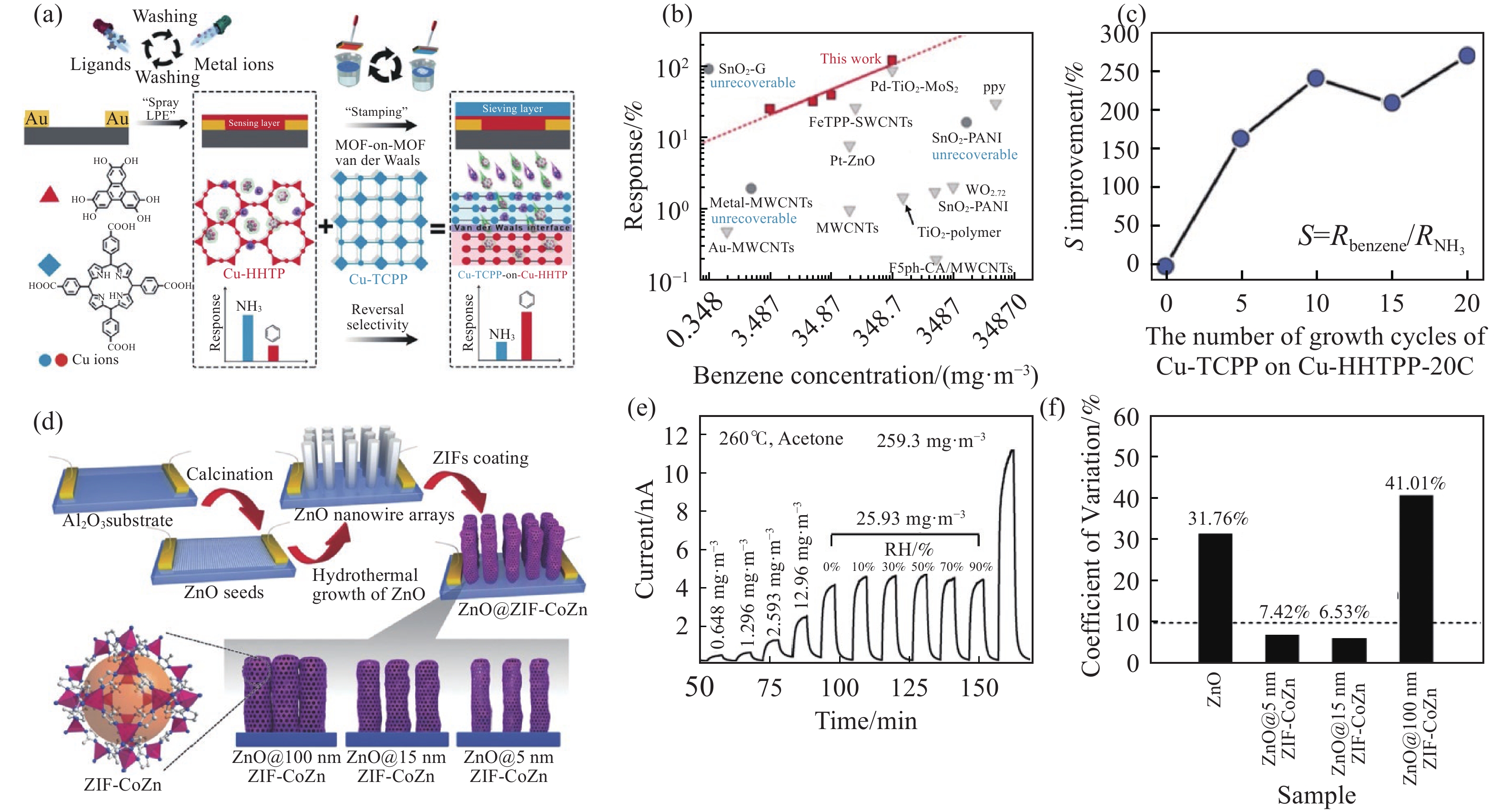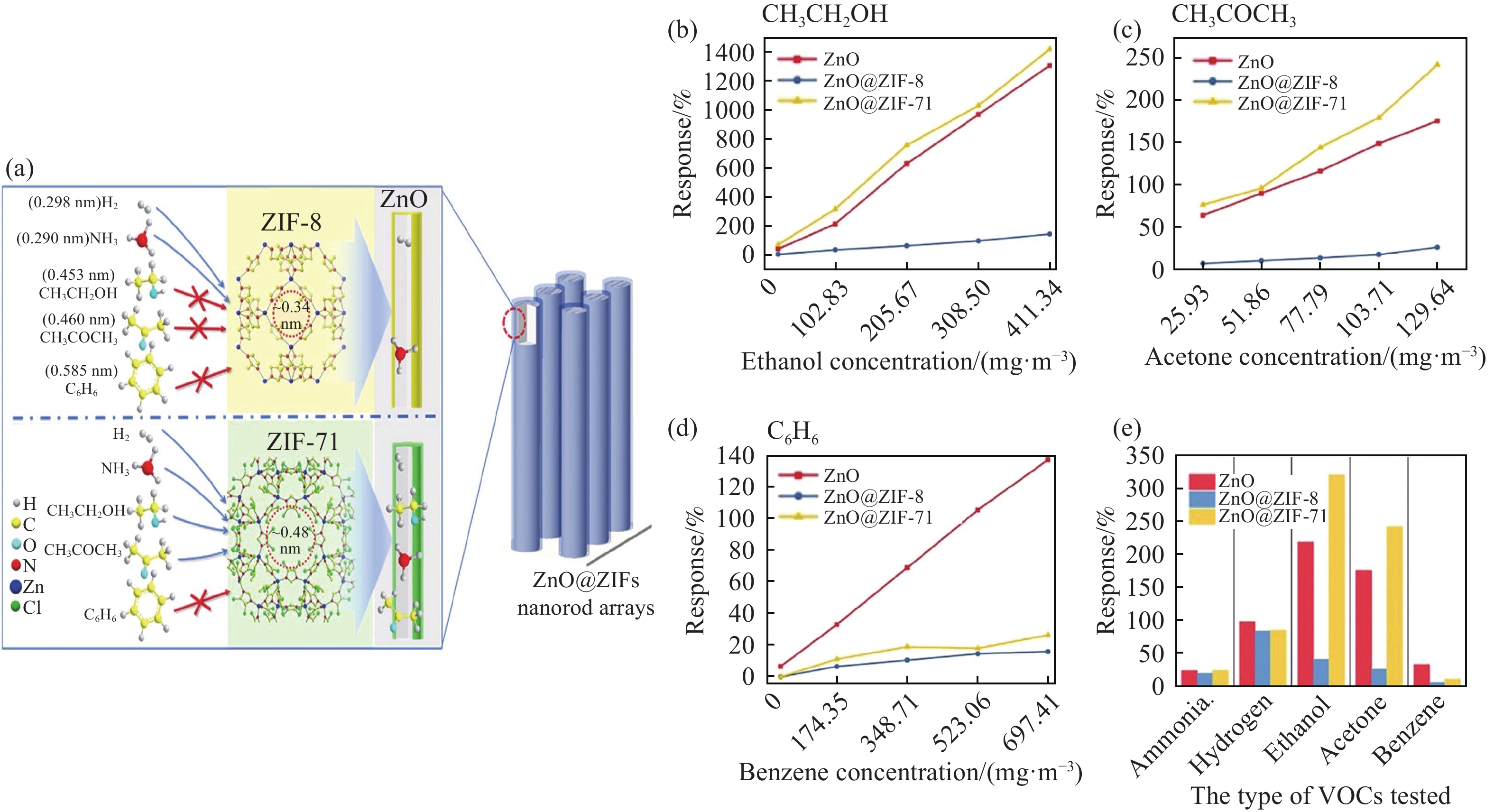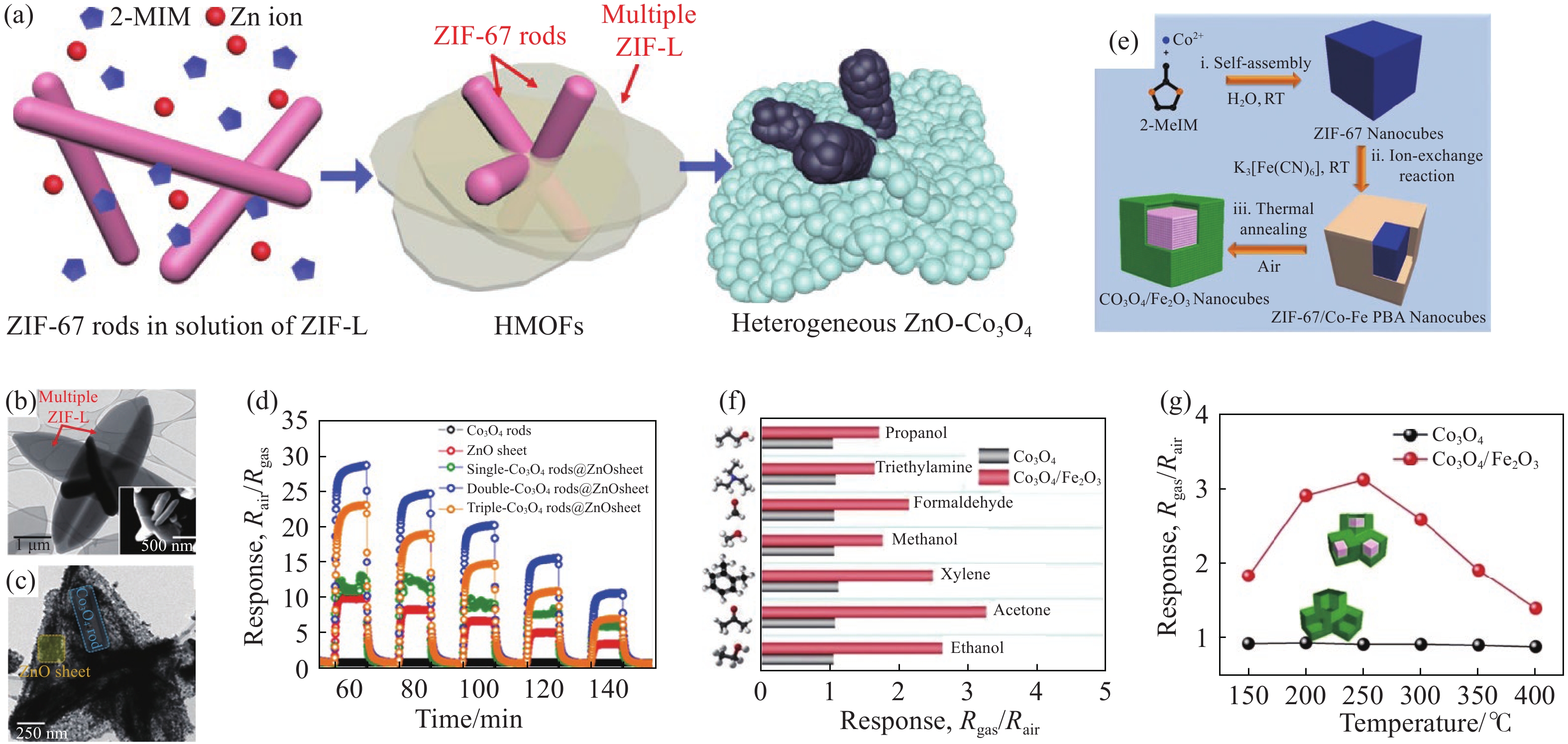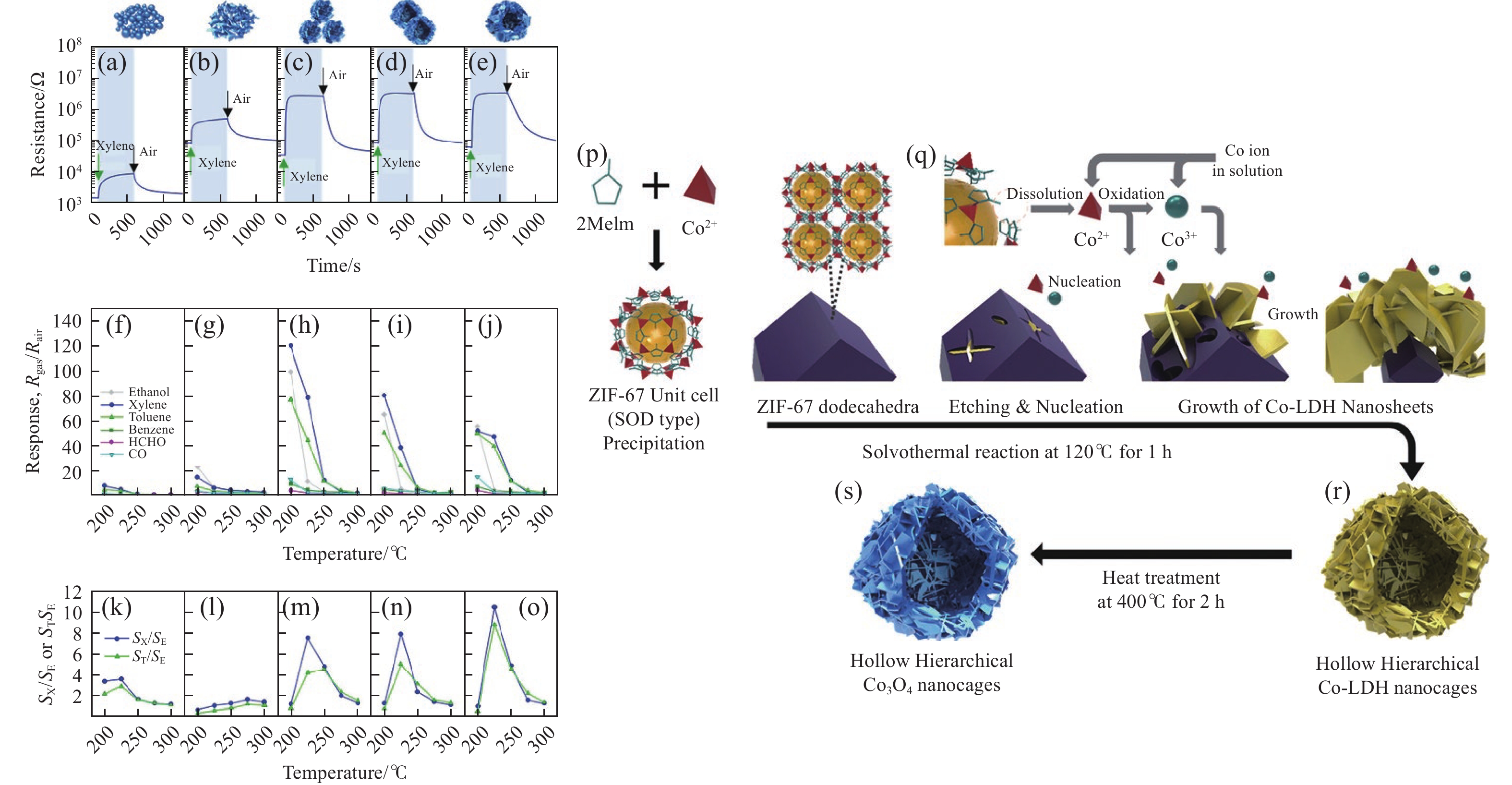Application of chemiresistive sensors based on the metal-organic framework for detecting volatile organic compounds
-
摘要: 化學電阻傳感器由于其結構簡單、分析快速等特點在眾多氣體傳感方式中脫穎而出,因此成為了目前應用廣泛的傳感器類型。其中,用于檢測揮發性有機化合物(VOCs)的電阻傳感器中敏感材料對氣體的選擇性吸附和相應的檢測至關重要,此外也需要一些額外措施保證檢測的選擇性。因此,傳感材料的比表面積、孔尺寸、功能官能團以及輔助材料等決定了傳感器的響應程度、選擇和敏感程度。金屬有機框架材料(MOF)是一類新型的有機?無機雜化材料,具有豐富多孔、高比表面積、結構多樣性、化學穩定性良好等特點,除此以外一些MOF衍生物也具有比表面積大、導電性良好等特點,因此MOF及MOF衍生物已在氣體傳感器中得到廣泛研究和應用。基于化學電阻傳感器基本原理、MOF及MOF衍生物在電阻傳感器檢測揮發性有機化合物中起到的作用、原理、及其應用,對其發展前景和面臨的挑戰進行了展望。Abstract: Chemical resistance sensors stand out among many gas sensing methods because of their simple structure, low-cost fabrication, facile integration with various electronic devices, and quick analysis; therefore, presently, they are widely used for gas sensing. Chemical resistance sensing is achieved by changing the electronic distribution of the sensing material. Among these chemical resistance sensors, the selective adsorption of gases and the corresponding detection of sensitive materials in the resistance sensor used for detecting volatile organic compounds (VOCs) are very important. In addition, measures to ensure the selectivity of detection are necessary. Therefore, the specific surface area, pore size and functional groups of sensing materials, and some auxiliary materials determine the response and sensitivity of the sensor. Metal-organic framework materials (MOFs) are a new class of organic-inorganic hybrid materials. It is characterized by rich porosity, high specific surface area, structural diversity, and chemical stability, making it exhibit good potential in the gas storage and separation field, catalysis field, and chemical sensing field. Some MOF derivatives, in addition to their properties, such as good electrical conductivity, have characteristics of MOF, such as high specific surface area. Therefore, MOF and its derivatives have been widely studied and applied as sensitive materials and filter media in gas sensors. Some MOF and MOF derivatives can be used as sensitive materials for chemical resistance sensors to improve the response to VOCs, and MOF membranes can also be used for their selective adsorption as a filter layer to improve the selectivity of sensors to the target gas. In this paper, the basic principle of chemical resistance sensors, the role, principle, and application of MOF and MOF derivatives in the detection of volatile organic compounds by resistance sensors are summarized, and the development prospect and challenges are discussed.
-
Key words:
- metal organic framework /
- derivatives /
- adsorption /
- volatile organic compounds /
- resistive sensors
-
圖 1 (a)M3(HHTP)2和M3(HITP)2的晶體結構(M=Cu或Ni);(b)使用MOF陣列分析數據對不同分析物的模式分析(橫、縱坐標標目中括號內的百分數分別表示主成分1與主成分2在成分分析所占的因素百分比);(c)2D MOFs對16種VOCs的傳感性能[17]
Figure 1. (a) Crystal structure of M3(HHTP)2 and M3(HITP)2; (b) pattern recognition of diverse analytes using 2D conductive MOF-based sensing data (The percentages in parantheses of horizontal and vertical coordinates indicate the percentage of principal component 1 and principal component 2 in component anlysis respectively); (c) sensing performance of 2D conductive MOFs toward 16 different VOCs[17]
圖 2 (a)摻雜HITP配體的Cu-HHTP-10C薄膜氣體傳感器制備示意圖;(b)對于不同還原性氣體響應的三維圖;(c)對三乙胺、甲烷、氫氣、丙酮、丁酮和乙苯對氨氣選擇性的提升[18]
Figure 2. (a) Schematic illustration of the preparation of HITP ligand-doped Cu-HHTP-10C thin film gas sensors; (b) three-dimensional wall chart of responses toward different reducing gases; (c) selectivity improvements toward triethylamine, methane, hydrogen, acetone, butanone, and ethylbenzene against NH3[18]
圖 3 (a)雙層MOF膜的制備以及將其作為高度選擇性苯傳感材料的應用示意圖;(b)Cu-TCPP-10C-on-Cu-HHTP-20C對苯氣體的響應曲線以及與報道的在室溫下工作的苯化學電阻氣體傳感器的比較;(c)對于Cu-TCPP-xC-on-Cu-HHTP-20C選擇性的提升[21]; (d) 由ZIF-CoZn包裹的ZnO納米線的合成示意圖;(e)ZnO@5nmZIF-CoZn對于干燥空氣氛圍下不同濃度的丙酮的響應/恢復曲線和對于25.93 mg·m?3質量濃度丙酮不同濕度范圍下的響應/恢復曲線;(f)260 ?C下對25.93 mg·m?3丙酮改變相對濕度從10%到90%傳感器的CV值[22]
Figure 3. (a) Illustration of the preparation of MOF-on-MOF thin films and application of the films as highly selective benzene-sensing materials; (b) response curve for Cu-TCPP-10C-on-Cu-HHTP-20C with respect to benzene gas and in comparison with reported benzene chemiresistive gas sensors working at RT; (c) selectivity improvements for Cu-TCPP-xC-on-Cu-HHTP-20C[21]; (d) schematic illustration of the preparation of ZnO@ZIF-CoZn; (e) response-recovery curves of ZnO@5nmZIF-CoZn to acetone with different concentrations in dry air and to 25.93 mg·m?3 acetone with different relative humidity; (f) CV of sensors by varying RH from 0% to 90% (acetone 25.93 mg·m?3, 260 ?C)[22]
圖 4 (a)利用ZIF-8和ZIF-71孔徑差異以及氣體分子大小來選擇通過氣體的機理圖;在250 °C下ZnO, ZnO@ZIF-8和ZnO@ZIF-71納米棒陣列三種傳感器的氣體濃度梯度響應曲線:(b)乙醇 (20.57, 102.83, 205.67, 308.50, 411.34 mg·m–3);(c)丙酮(25.93, 51.86, 77.79, 103.71, 129.64 mg·m?3);(d)苯(34.87, 174.35, 348.71, 523.06, 697.41 mg·m?3);(e)三種傳感器暴露于102.83 mg·m?3乙醇、129.64 mg·m?3丙酮、174.35 mg·m?3苯的響應值(相同VOCs體積濃度)[23]
Figure 4. (a) Mechanism of using the difference between the pore sizes of ZIF-8 and ZIF-71 and gas molecular sizes to select gases passing the ZIFs membrane of ZnO@ZIF NRAs; gas concentration gradient response curves of ZnO NRAs, ZnO@ZIF-8 NRAs, and ZnO@ZIF-71 NRAs at 250 °C: (b) ethanol (20.57, 102.83, 205.67, 308.50, 411.34 mg·m?3); (c) acetone (25.93, 51.86, 77.79, 103.71, 129.64 mg·m?3); (d) benzene (34.87, 174.35, 348.71, 523.06, 697.41 mg·m?3); (e) The response values of the three sensors to 102.83 mg·m?3 ethanol, 129.64 mg·m?3 acetone and 174.35 mg·m?3 benzene (the same VOCs volume concentration)[23]
圖 5 (a)非均相雜化MOF和以其為模版的ZnO-Co3O4分層復合結構合成示意圖;(b)2-ZIF-L@ZIF-67棒透射電子顯微鏡圖像和掃描電子顯微鏡圖像;(c)2-Co3O4棒@ZnO片透射電子顯微鏡圖像;(d)在450 °C質量濃度范圍為2.59~12.96 mg·m?3的丙酮響應[24];(e)Co3O4/Fe2O3形成示意圖; 基于Co3O4/Fe2O3和Co3O4的傳感器對:(f)相同體積分數(10-4)不同VOCs檢測效果(丙醇268.28 mg·m?3、三乙胺451.74 mg·m?3、甲醛134.06 mg·m?3、甲醇143.04 mg·m?3、二甲苯473.97 mg·m?3、丙酮259.29 mg·m?3、乙醇205.67 mg·m?3);(g)不同溫度對259.29 mg·m?3丙酮響應[25]
Figure 5. (a) Schematic illustration of the synthetic process for heterogeneous HMOF and HMOF-templated heterogeneous ZnO-Co3O4 hierarchical composite structures; (b) Transmission Electron Microscope image with inset of the corresponding Scanning Electron Microscope image of double-ZIF-L@ZIF-67 rods; (c) Transmission Electron Microscope image of the 2-Co3O4@ZnO sheet; (d) dynamic acetone-sensing transition in the concentration range of 2.59?12.96 mg·m?3 of acetone at 450 °C[24]; (e) schematic illustration of the formation process of Co3O4/Fe2O3 nanocubes; (f) response values of different VOCs with the same volume fraction (10?4) (propanol 268.28 mg·m?3, trithylamine 451.74 mg·m?3, formaldehyde 134.06 mg·m?3, methanol 143.04 mg·m?3, xylene 473.97 mg·m?3, acetone 259.29 mg·m?3, ethanol 205.67 mg·m?3); (g) response towards 259.29 mg·m?3 acetone at different temperatures[25]
圖 6 在225 °C下:(a)C-Co3O4,(b)03-Co3O4, (c) 10-Co3O4, (d) 20-Co3O4,(e)40-Co3O4中空分層顆粒對23.70 mg·m?3的對二甲苯響應曲線;(f~j)在200~300 °C下5種傳感器對10.28 mg·m?3乙醇、23.70 mg·m?3對二甲苯、20.57 mg·m?3甲苯、17.44 mg·m?3苯、6.70 mg·m?3甲醛和6.25 mg·m?3一氧化碳的氣體響應(Rgas/Rair)(不同VOCs體積分數相同); (k~o) 在乙醇作為干擾時5種傳感器檢測對二甲苯和甲苯的選擇性;(p~s)用ZIF-67制備Co3O4納米籠的制備示意圖[26]
Figure 6. Dynamic sensing transients of (a) C-Co3O4, (b) 03-Co3O4, (c) 10-Co3O4, (d) 20-Co3O4, and (e) 40-Co3O4 hollow hierarchical particles to 23.70 mg·m?3 of p-xylene at 225 °C; (f–j) gas responses (Rgas/Rair) of five sensors to 10.28 mg·m?3 ethanol, 23.70 mg·m?3 p-xylene, 20.57 mg·m?3 toluene, 17.44 mg·m?3 benzene, 6.70 mg·m?3 formaldehyde, and 6.25 mg·m?3 carbon monoxide at 200–300°C (the volume fraction of different VOCs is the same); (k–o) selectivity toward p-xylene and toluene over the interfering ethanol gas of five sensors; (p–s) schematic of the preparation of hollow hierarchical Co3O4 nanocages[26]
www.77susu.com<span id="fpn9h"><noframes id="fpn9h"><span id="fpn9h"></span> <span id="fpn9h"><noframes id="fpn9h"> <th id="fpn9h"></th> <strike id="fpn9h"><noframes id="fpn9h"><strike id="fpn9h"></strike> <th id="fpn9h"><noframes id="fpn9h"> <span id="fpn9h"><video id="fpn9h"></video></span> <ruby id="fpn9h"></ruby> <strike id="fpn9h"><noframes id="fpn9h"><span id="fpn9h"></span> -
參考文獻
[1] Barea E, Montoro C, Navarro J A R. Toxic gas removal – metal–organic frameworks for the capture and degradation of toxic gases and vapours. Chem Soc Rev, 2014, 43(16): 5419 doi: 10.1039/C3CS60475F [2] Wang H, Lustig W P, Li J. Sensing and capture of toxic and hazardous gases and vapors by metal–organic frameworks. Chem Soc Rev, 2018, 47(13): 4729 doi: 10.1039/C7CS00885F [3] Zhu Q, Zhang Y M, Hu C Y, et al. Progress of research on modified oxide semiconductor gas sensor. J Funct Mater, 2014, 45(17): 17017 doi: 10.3969/j.issn.1001-9731.2014.17.003朱琴, 張裕敏, 胡昌義, 等. 氧化物半導體氣敏傳感器的改性研究進展. 功能材料, 2014, 45(17):17017 doi: 10.3969/j.issn.1001-9731.2014.17.003 [4] Zang X N, Zhou Q, Chang J, et al. Graphene and carbon nanotube (CNT) in MEMS/NEMS applications. Microelectron Eng, 2015, 132: 192 doi: 10.1016/j.mee.2014.10.023 [5] Choi S J, Kim I D. Recent developments in 2D nanomaterials for chemiresistive-type gas sensors. Electron Mater Lett, 2018, 14(3): 221 doi: 10.1007/s13391-018-0044-z [6] Kim I D, Rothschild A, Tuller H L. Advances and new directions in gas-sensing devices. Acta Mater, 2013, 61(3): 974 doi: 10.1016/j.actamat.2012.10.041 [7] Zhao M T, Yuan K, Wang Y, et al. Metal–organic frameworks as selectivity regulators for hydrogenation reactions. Nature, 2016, 539(7627): 76 doi: 10.1038/nature19763 [8] Zhou H C, Kitagawa S. Metal-organic frameworks (MOFs). Chem Soc Rev, 2014, 43(16): 5415 doi: 10.1039/C4CS90059F [9] Zou X Y, Chen M, Cao X Q, et al. Review of application of MOF materials for removal of environmental pollutants from water (Ⅰ). Chin J Eng, 2020, 42(3): 289鄒星云, 陳明, 曹曉強, 等. MOF材料在水環境污染物去除方面的應用現狀及發展趨勢(Ⅰ). 工程科學學報, 2020, 42(3):289 [10] Fei H H, Paw U L, Rogow D L, et al. Synthesis, characterization, and catalytic application of a cationic metal–organic framework: Ag2(4, 4'-bipy)2(O3SCH2CH2SO3). Chem Mater, 2010, 22(6): 2027 doi: 10.1021/cm9032308 [11] Koo W T, Jang J S, Kim I D. Metal-organic frameworks for chemiresistive sensors. Chem, 2019, 5(8): 1938 doi: 10.1016/j.chempr.2019.04.013 [12] Zhang L T, Zhou Y, Han S T. The role of metal-organic frameworks in electronic sensors. Angewandte Chemie Int Ed, 2021, 60(28): 15192 doi: 10.1002/anie.202006402 [13] Campbell M, Dinc? M. Metal–organic frameworks as active materials in electronic sensor devices. Sensors, 2017, 17(5): 1108 doi: 10.3390/s17051108 [14] Zhai Z Y, Zhang X L, Li C J. Research progress of metal organic framework (MOFs)/fiber materials used in resistive gas sensors. Chin J Eng, 2020, 42(9): 1096翟振宇, 張秀玲, 李從舉. 金屬有機骨架(MOFs)/纖維材料用于電阻式氣體傳感器的研究進展. 工程科學學報, 2020, 42(9):1096 [15] Kirchon A, Feng L, Drake H F, et al. From fundamentals to applications: A toolbox for robust and multifunctional MOF materials. Chem Soc Rev, 2018, 47(23): 8611 doi: 10.1039/C8CS00688A [16] Smith M K, Mirica K A. Self-organized frameworks on textiles (SOFT): Conductive fabrics for simultaneous sensing, capture, and filtration of gases. J Am Chem Soc, 2017, 139(46): 16759 doi: 10.1021/jacs.7b08840 [17] Campbell M G, Liu S F, Swager T M, et al. Chemiresistive sensor arrays from conductive 2D metal-organic frameworks. J Am Chem Soc, 2015, 137(43): 13780 doi: 10.1021/jacs.5b09600 [18] Wu A Q, Wang W Q, Zhan H B, et al. Layer-by-layer assembled dual-ligand conductive MOF nano-films with modulated chemiresistive sensitivity and selectivity. Nano Res, 2021, 14(2): 438 doi: 10.1007/s12274-020-2823-8 [19] Yao M S, Lv X J, Fu Z H, et al. Layer-by-layer assembled conductive metal-organic framework nanofilms for room-temperature chemiresistive sensing. Angewandte Chemie Int Ed, 2017, 56(52): 16510 doi: 10.1002/anie.201709558 [20] Hu N, Yang Z, Wang Y, et al. Ultrafast and sensitive room temperature NH3 gas sensors based on chemically reduced graphene oxide. Nanotechnology, 2014, 25(2): 025502 doi: 10.1088/0957-4484/25/2/025502 [21] Yao M S, Xiu J W, Huang Q Q, et al. Van der waals heterostructured MOF-on-MOF thin films: Cascading functionality to realize advanced chemiresistive sensing. Angewandte Chemie, 2019, 131(42): 15057 doi: 10.1002/ange.201907772 [22] Yao M S, Tang W X, Wang G E, et al. MOF thin film-coated metal oxide nanowire array: Significantly improved chemiresistor sensor performance. Adv Mater, 2016, 28(26): 5229 doi: 10.1002/adma.201506457 [23] Zhou T T, Sang Y T, Wang X X, et al. Pore size dependent gas-sensing selectivity based on ZnO@ZIF nanorod arrays. Sens Actuat B:Chem, 2018, 258: 1099 doi: 10.1016/j.snb.2017.12.024 [24] Jang J S, Koo W T, Kim D H, et al. In situ coupling of multidimensional MOFs for heterogeneous metal-oxide architectures: Toward sensitive chemiresistors. ACS Central Sci, 2018, 4(7): 929 doi: 10.1021/acscentsci.8b00359 [25] Xu K, Zhao W, Yu X, et al. MOF-derived Co3O4/Fe2O3 p-n hollow cubes for improved acetone sensing characteristics. Phys E Low Dimensional Syst Nanostructures, 2020, 118: 113869 doi: 10.1016/j.physe.2019.113869 [26] Jo Y M, Kim T H, Lee C S, et al. Metal–organic framework-derived hollow hierarchical Co3O4 nanocages with tunable size and morphology: Ultrasensitive and highly selective detection of methylbenzenes. ACS Appl Mater Interfaces, 2018, 10(10): 8860 doi: 10.1021/acsami.8b00733 -




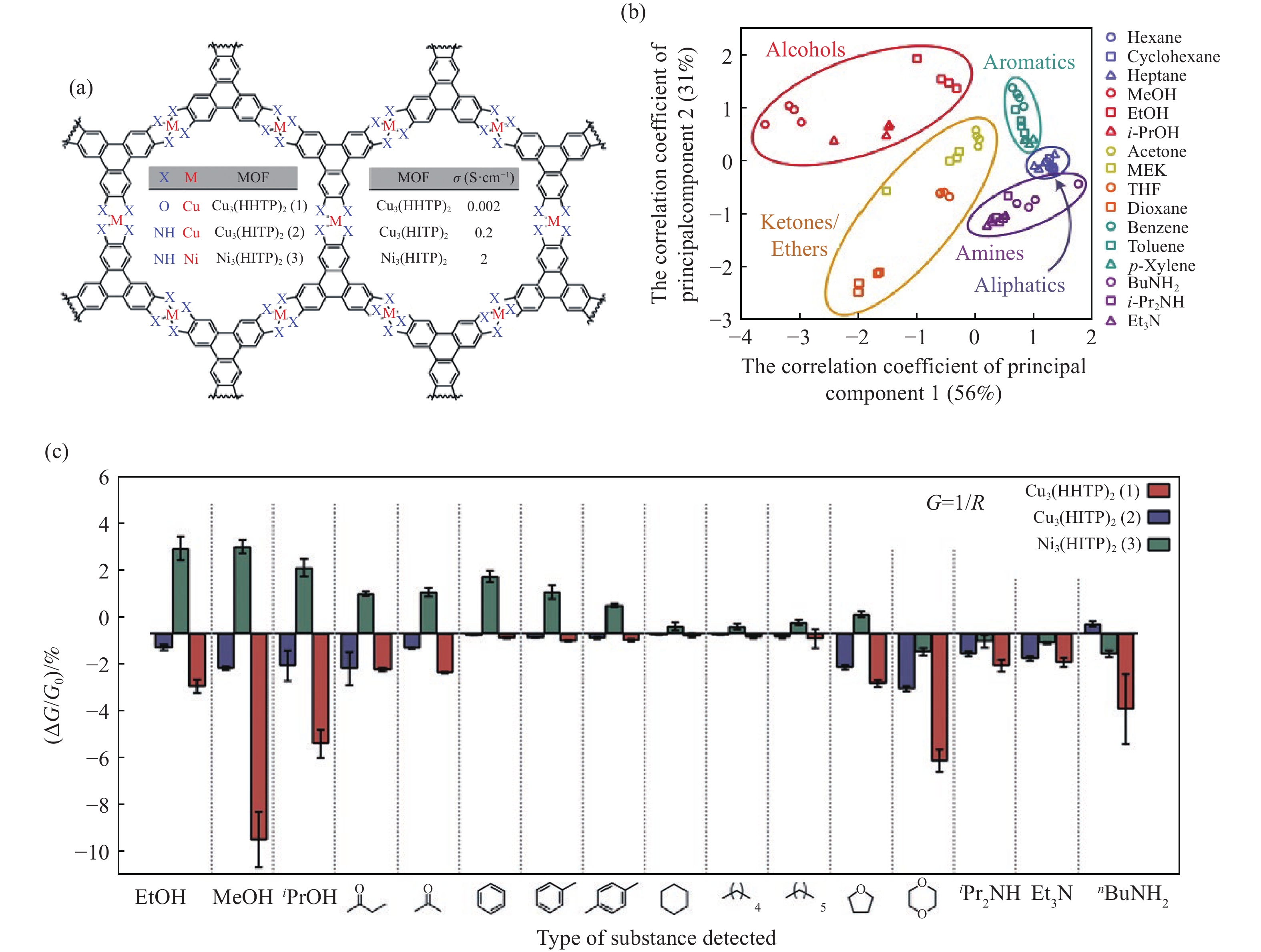
 下載:
下載:
